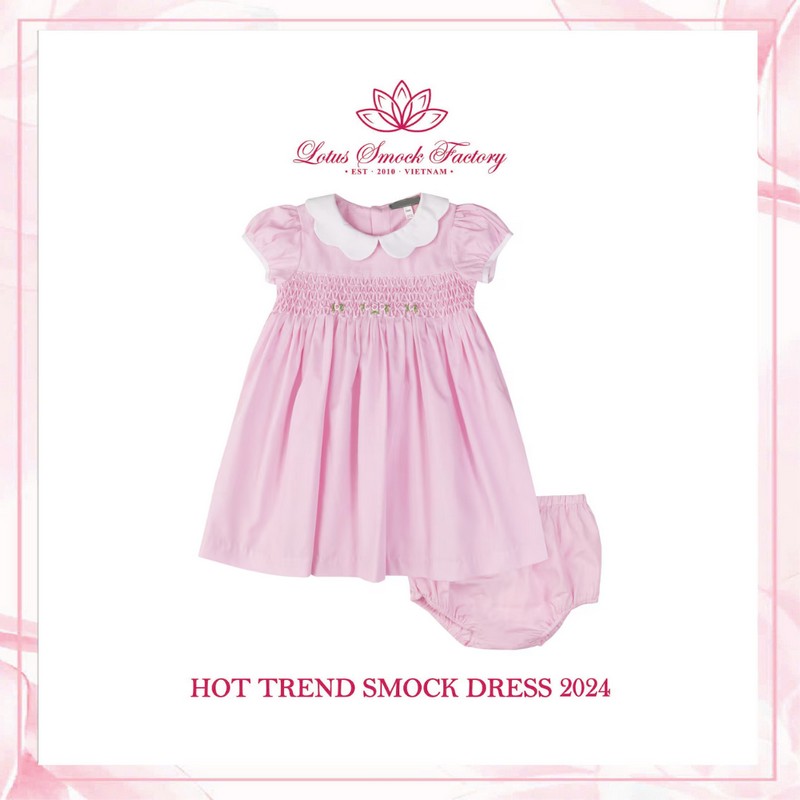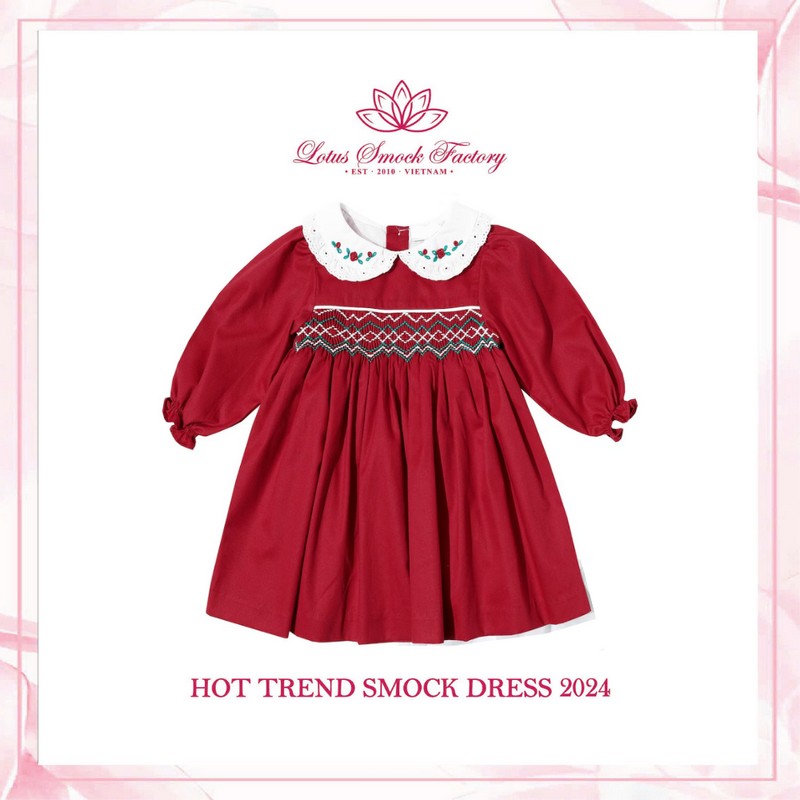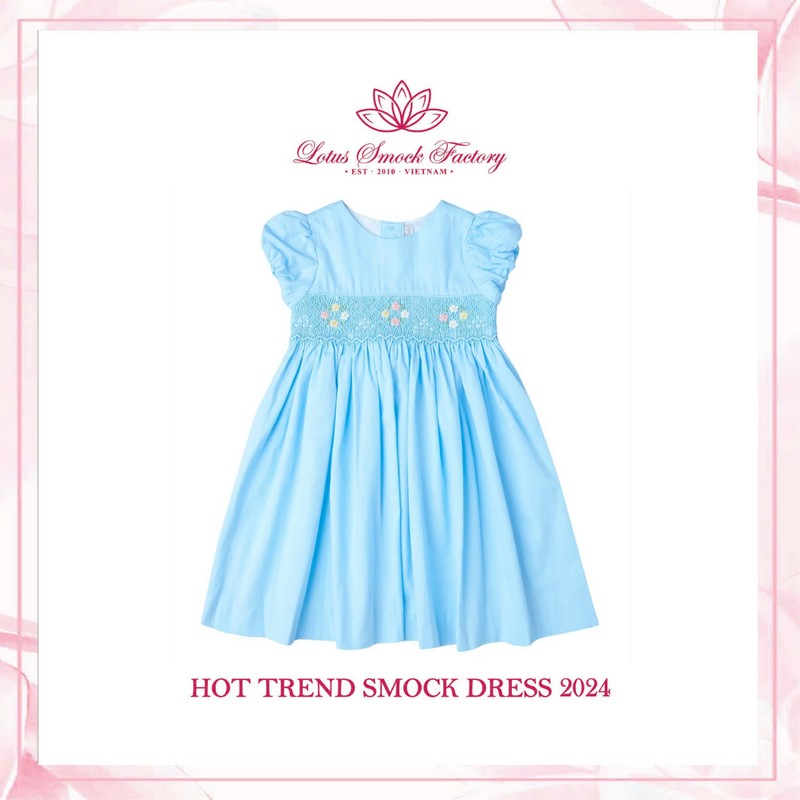Lotus Smock
12 posts
Nov 02, 2025
12:23 AM

|
In the realm of embroidery and handcrafted fashion, the smocked dress stands as an everlasting symbol of grace, skill, and tradition. Characterized by its gathered pleats and intricate hand stitching, this dress reflects centuries of artistry and cultural heritage. Whether worn by children for formal occasions or featured in high-end couture collections, the smocked dress continues to enchant with its timeless beauty and meticulous craftsmanship. It is not merely a piece of clothing—it is a canvas where embroidery and fabric come together to tell a story of patience, precision, and passion.

See Article Details At: Smocked Dress
The Origins of Smocking and Its Journey Through Time
The art of smocking has a history that dates back to medieval England, where it was originally used to add flexibility to garments before elastic materials existed. Laborers and farmers wore smocked shirts and dresses because the gathered fabric provided both comfort and stretch. What began as a functional technique soon evolved into a decorative art form as artisans discovered the beauty of embroidered patterns stitched over pleated fabric.
View At: The Charm of Smocked Dresses

By the 18th and 19th centuries, smocking became an essential feature of fine dressmaking, particularly in women’s and children’s clothing. The smocked dress, with its structured yet delicate silhouette, grew in popularity among the upper classes. Each piece was hand-stitched with care, often taking several days to complete. The embroidery transformed everyday fabric into a masterpiece of design—an expression of elegance and craftsmanship that transcended generations.
View At: Smocked Dress: The Art of Embroidery Woven into Timeless Fashion

Even today, smocking remains one of the most beloved forms of traditional embroidery, cherished for its beauty, versatility, and connection to handmade artistry.
See More At: Smocked Dress: A Classic Expression of Embroidery and Elegance
The Technique: Where Fabric Meets Embroidery
Smocking is a specialized embroidery technique that combines structure and decoration. It begins by pleating the fabric evenly—traditionally done by hand or using a pleating machine. Once the pleats are formed, they are stitched together with embroidery threads in patterns that add both elasticity and ornamentation. The result is a section of gathered fabric that stretches slightly, creating a soft, textured design that moves beautifully when worn.
Common stitches used in smocking include the cable stitch, honeycomb stitch, trellis stitch, and wave stitch. Each stitch type creates a distinct rhythm and visual effect. Artisans often incorporate floral or geometric motifs within these patterns, using colored threads to enhance the overall design. The embroidery can be subtle and understated or bold and vibrant, depending on the desired style.
What makes smocking so captivating is its dual purpose—it is both functional and decorative. The embroidery reinforces the pleats while adding visual depth and personality to the garment. This seamless fusion of practicality and artistry is what has allowed smocking to endure as a hallmark of embroidery craftsmanship.
Materials and Design Elements
The magic of a smocked dress begins with the right fabric. Lightweight materials such as cotton, voile, linen, and batiste are preferred because they pleat easily and provide a soft drape. For formal occasions, silk or satin may be used to add a luxurious finish. The embroidery threads—usually cotton, silk, or rayon—are carefully chosen to complement the base fabric and emphasize the fine details of the stitching.
Traditional smocked dresses often feature gentle pastel shades like ivory, pale pink, or sky blue, which highlight the delicate embroidery work. However, modern designs experiment with brighter colors, printed fabrics, and contrasting threadwork. The dress’s silhouette—often marked by puffed sleeves, a rounded neckline, and a gathered skirt—enhances its timeless appeal. Lace trims, ruffles, and hand-sewn buttons are frequently added to create a romantic and refined finish.
The Cultural and Emotional Significance
Beyond its aesthetic charm, the smocked dress holds deep emotional and cultural value. For many families, these dresses are treasured heirlooms passed down through generations. They mark important milestones such as christenings, birthdays, and weddings. Every pleat and stitch tells a story of care, love, and tradition. Wearing or gifting a smocked dress often symbolizes continuity—a bridge between past and present, between generations of craftsmanship.
In the field of embroidery, smocking represents one of the purest forms of hand artistry. It requires a steady hand, a sharp eye for symmetry, and a genuine passion for the craft. The hours spent creating a single dress reflect the artisan’s commitment to excellence. In an era where fashion is often fast and fleeting, smocking stands as a celebration of slow, meaningful creation.
Modern Adaptations and Sustainable Appeal
While the smocked dress remains rooted in history, it has adapted beautifully to modern fashion trends. Designers today reinterpret smocking through innovative materials, digital patterns, and contemporary silhouettes. From summer sundresses to elegant evening wear, smocking adds texture, personality, and a touch of nostalgia to modern designs. Even in fast fashion, smocking-inspired pieces remain popular for their feminine charm and comfortable fit.
Interestingly, the rise of sustainable and slow fashion has renewed appreciation for traditional embroidery techniques like smocking. Consumers now seek garments made with care and authenticity, valuing quality over quantity. Hand-smocked dresses perfectly embody these values—they are durable, ethical, and timeless. Each one is a labor of love, connecting the wearer to the artisan and the artistry of generations past.
In today’s world, where mass production dominates, the smocked dress stands as a quiet reminder of what fashion can and should be: meaningful, beautiful, and crafted with intention.
Conclusion
The smocked dress is more than a piece of clothing—it is a living expression of embroidery’s enduring artistry. Every pleat, every thread, and every hand-stitched pattern speaks of dedication, creativity, and tradition. From its humble beginnings as a practical sewing technique to its status as a symbol of timeless elegance, the smocked dress continues to inspire admiration across cultures and generations. In a world that moves fast, it reminds us of the simple, lasting beauty of things made by hand—with heart, skill, and love.
At Lotus Smock, we redefine wholesale smocked clothing with a blend of tradition and innovation. Known for our smocked dresses, kidswear, and customized designs, Lotus Smock uses premium fabrics and skilled Vietnamese artisanship to create clothing that delights worldwide customers. #Smocked_Clothing_Business_Knowledge, #SmockedClothingBusinessKnowledge, #Lotus_Smock, #LotusSmock, #Lotus_Smock
|